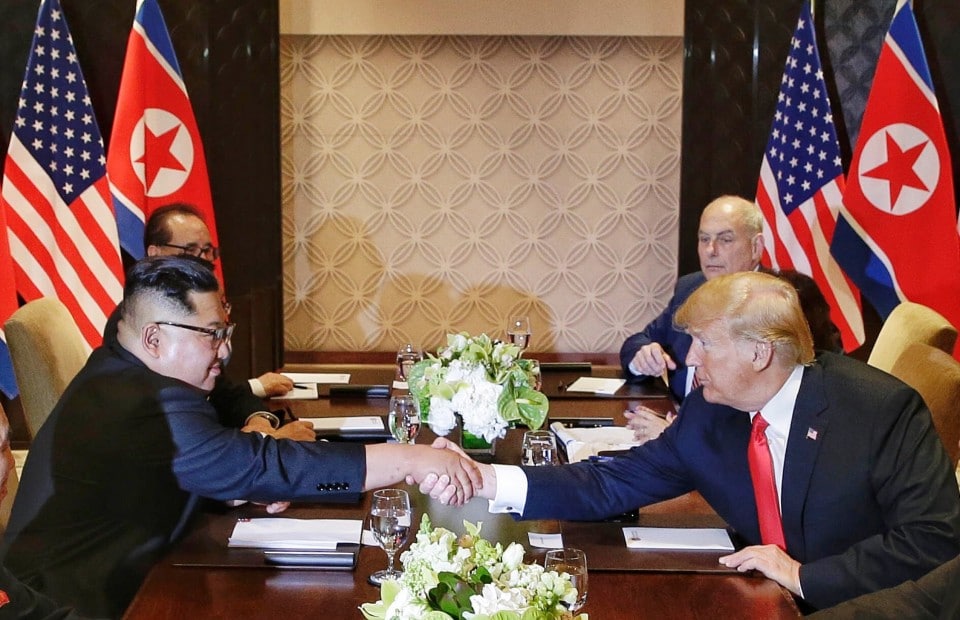Tetsuo Kotani is an associate professor at Meikai University and a senior fellow at the Japan Institute of International Affairs.
URAYASU, Japan — Following the historic meeting with North Korean leader Kim Jong Un in Singapore this week, U.S. President Donald Trump announced a halt to “expensive” and “provocative” U.S.-South Korea military exercises on the Korean Peninsula. He also indicated that at some point, the United States might withdraw its 32,000 troops from South Korea. “I want to get our soldiers out,” he said. “I want to bring our soldiers back home. But that’s not part of the equation right now. I hope it will be eventually.” North Korean state media spun Trump’s comments as an acceptance of Kim’s demands. United States Forces Korea (USFK) may remain in South Korea for some time but will do so without sufficient readiness.
Trump’s decision caught Seoul, Tokyo and the USFK itself off guard, but it encouraged Beijing and Pyongyang. North Korea has long opposed U.S.-South Korea joint military exercises as a prelude to invasion and justified its nuclear weapons development as self-defense measures to counter America’s hostile policy. Trump may think the agreement to establish “new U.S.-[North Korea] relations” is a win-win. But actually, Kim has been rewarded greatly for just suspending missile tests, without even giving up his nuclear arsenal yet.
In a broader sense, Trump may be repeating what U.S. Secretary of State Dean Acheson, under the Harry Truman administration, did in a 1950 speech in Washington. Acheson set the notorious “Acheson Line,” a defensive perimeter running along the Aleutian Islands in Alaska to Japan and then to the Philippines to counter Communist threats in Asia. A few months before his speech, the United States had withdrawn its forces from South Korea, following the Soviet Union’s own withdrawal two years earlier.
Acheson’s speech set a protected zone that didn’t include the Korean Peninsula. Though there is no credible historical evidence that the Acheson Line induced North Korean founder Kim Il Sung to initiate armed aggression against South Korea, we do know that Moscow and Beijing were aware and supportive of his invasion of the South and that at the least, the Acheson Line provided a context for the Korean War.
The difference between Acheson and Trump is that the latter, rather than acknowledging reality, might establish a new norm by disabling, scaling down and ultimately withdrawing the U.S. presence on the Korean Peninsula whether or not he understands the strategic implications of his decision.
Trump has cast doubt on the cost-effectiveness of the USFK with his “America First” instinct. Trump is not the first U.S. president to scale back the USFK. Richard Nixon did, seeking to reduce the financial burden, and Jimmy Carter tried to pull back all ground troops from the Korean Peninsula to reduce U.S. overseas interventions. Perhaps Trump’s motive is a mixture of these two predecessors of his.
In some sense, a revision to the USFK is inevitable in the near future, for two reasons. First, because Seoul and Pyongyang agreed in the Panmunjom Declaration to a peace treaty to end the Korean War, the USFK presence would be affected anyway. Second, as South Korean President Moon Jae-in’s government is willing to regain wartime operational control from USFK by 2022, the Pentagon has no choice but to review USFK’s function, which is the only operational control under the U.S. Indo-Pacific Command. U.S. Forces Japan, for instance, does not have operational control.
But Trump might change the military balance in Northeast Asia too rapidly. The tension across the 38th parallel is now reduced, but North Korea’s nuclear arsenals remain, as does massive heavy artillery along the Demilitarized Zone. South Korea might prefer the reduced tension over USFK maintenance. The reduced tension on the Korean Peninsula would give China more room to maneuver in the region, and Beijing could shift its focus from Korea to somewhere else — Taiwan, for instance. Taipei would be concerned about the implications for the Taiwan Strait if the USFK withdrew.
The Trump Line might leave Japan as a frontline state vis-à-vis authoritarian regimes on the Asian continent. Some Japanese defense experts are already worried that the Tsushima Strait might become a new hot spot instead of Korea’s Demilitarized Zone. In fact, Trump might consider U.S. Forces Japan (USFJ) too costly too, now that Northeast Asia is more peaceful, while a trade deficit with Japan remains. In this case, Tokyo would have to review its long-standing security strategy based on its alliance with Washington. Going nuclear is Japan’s second-to-last option. Its last option is to accept Chinese dominance, or Pax Sinica.
On the other hand, the review of the USFK might lead to a review of USFJ in a more positive way, transferring operational control from the former to the latter. If so, that would provide an opportunity to enhance command and control coordination between USFJ and Japan’s Self-Defense Force. In fact, it makes more sense for the United States to transform the USFJ into an operational command to better prepare for strategic competition with China. Remember, the U.S. operational command existed in Tokyo during the Korean War.
Trump regards the Singapore summit as the beginning of a process. But the process is not merely about Korea — it’s about the entire geostrategic landscape in Asia. It is still too early to tell whether or not the denuclearization of the Korean Peninsula will proceed. One thing is clear, though: the Trump Line is already providing a new context for the U.S.-China strategic competition.
This was produced by The WorldPost, a partnership of the Berggruen Institute and The Washington Post.





